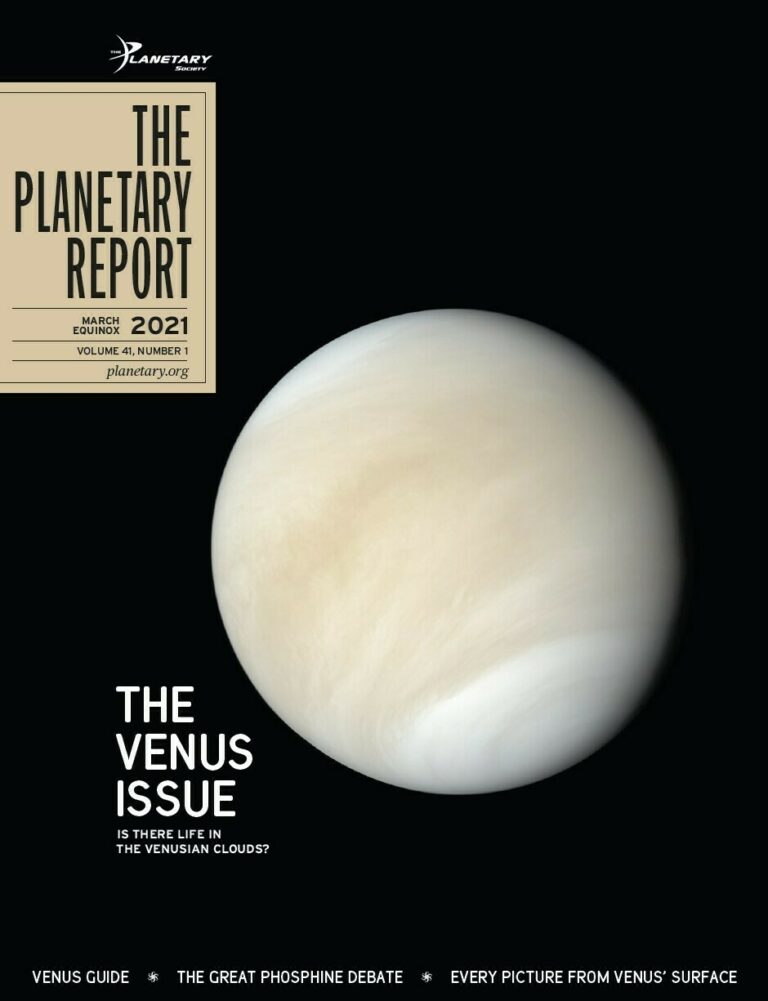
On the Cover: This view of Venus was created using 78 frames captured by NASA’s Mariner 10 spacecraft in 1974 through orange and ultraviolet filters. It approximates Venus’ natural color, though ultraviolet filters make the cloud patterns more visible than they would be to the human eye. Credit: NASA/JPL/Mattias Malmer
Download PDF
Features
March Equinox 2021
The Quest for Life on Venus
Did scientists detect a signature of life in Venus' clouds? Or will the bombshell finding be proven false?
Your Impact: March Equinox 2021
Thanks to our members, we hosted Planetfest '21, advocated for space, and took a big STEP forward with our new sci-tech grants program.
Every picture from Venus' surface, ever
In 1975 and 1982, four of the Soviet Union’s Venera probes captured our only images of Venus’ surface.
Your Place in Space
All Eyes on Venus: Taking a Closer Look at the Mystery-Shrouded Planet Next Door
By Bill Nye, Planetary Society CEO
When I was a kid, Venus was imagined to be a tropical world inhabited by microbes, perhaps, but also a great many Venusians—and a few monsters. Since then, our understanding of Venus has changed substantially. Recent research has once again raised the possibility of Venusian life, inspiring us to devote this issue to a deep (and well-protected) dive into this mysterious and surprising world.
In September 2020, a group of researchers announced that they had detected phosphine gas in Venus’ atmosphere, perhaps indicating that some kind of life form(s) might be floating high in the Venusian sky. As I hope you’d expect, other scientists have challenged this claim, suggesting that the readings of phosphine, which is similar to ammonia, are not accurate. Even if this particular gas does exist in the atmosphere of Venus, there’s nothing to prove that life produced it. However this all pans out, one thing is certain: Venus has caught our attention.
We have glimpsed the surface of Venus with both radar measurements and a few images sent back during the Soviet Venera program in the 1970s and ‘80s, which included cameras on the surface for a few minutes (before being cooked to death) and spacecraft hulls sending back a little data about the extreme atmospheric pressure there (before being crushed to death). With so little information, the whole history of the planet has been up for debate for at least 40 years.
Scientists generally agree that much like Earth, Venus once had liquid water on its surface, perhaps for as long as 2 billion years, but somewhere along the way, Venus went down a very different path. Because of a strong greenhouse effect that ran away billions of years ago, Venus is a hellscape with atmospheric pressure 90 times that of Earth and surface temperatures of more than 400 degrees Celsius (800 degrees Fahrenheit). Above Earth’s surface, we have clouds of water droplets that fall down to the land and sea as rain, sleet, or snow. On Venus, the clouds are sulfuric acid, and the surface is so hot that the resulting acid rain evaporates before it gets to the ground. As our own planet warms by means of our own greenhouse effect, the history of Venus serves as a cautionary tale of just how much a planet can change.
Phosphine or not, this fascinating world may hold answers to the most important questions of all: how does or did life begin? Are Earthlings the lone living things in the solar system? As we invest in the exploration of Venus, we’ll learn more about our own world and ultimately our place in the cosmos—our place in space. Onward!
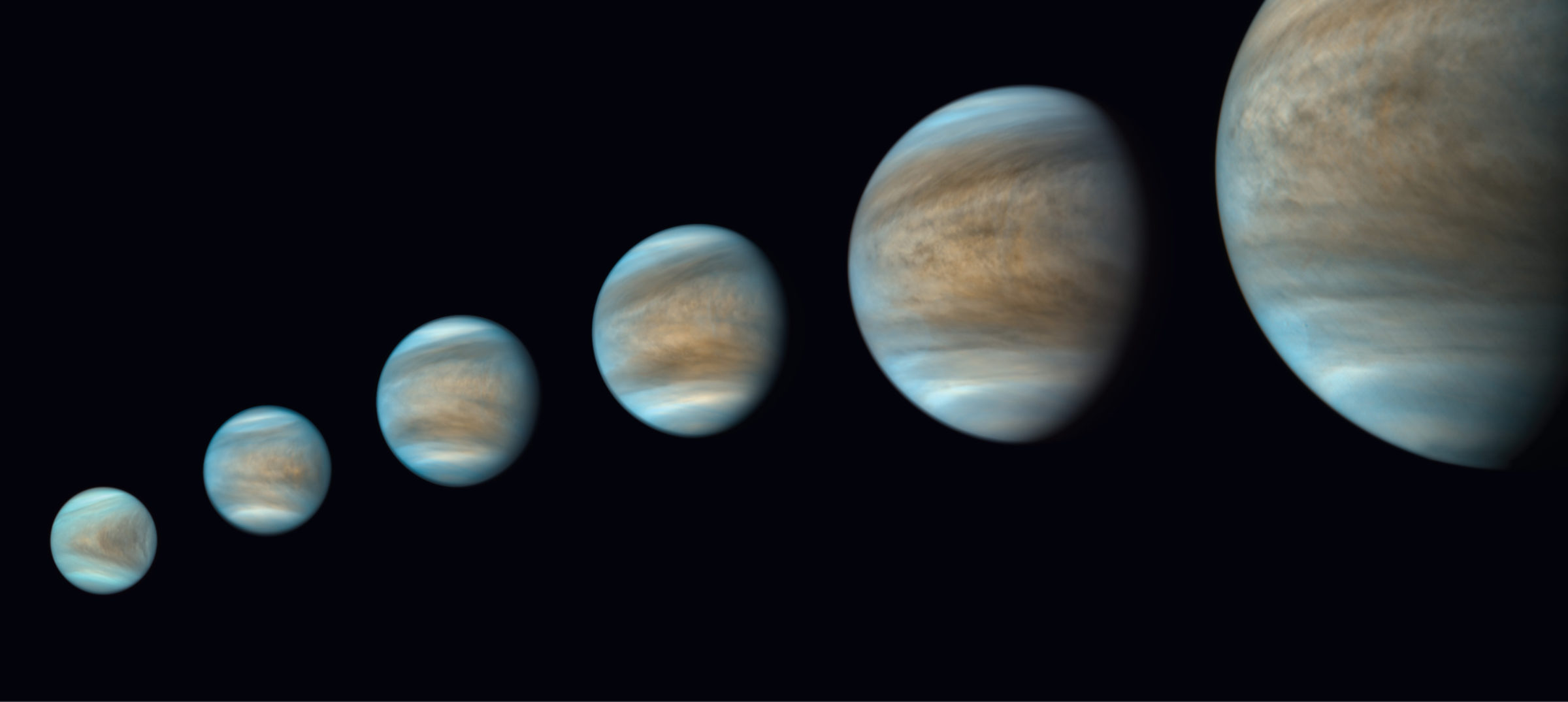
Members on Deck
What fuels your curiosity about Venus?
We asked members to share their thoughts and feelings about Venus. What fuels your curiosity about this world? Here are some of the responses you shared with us.
I grew up reading Robert Heinlein’s science fiction and so imagined Venus as a warm, swampy place with interesting natives harboring strange taboos. The sequence of Soviet and American probes revealed a far less friendly place but equally intriguing. I hope to learn more of what sent it on its remarkable path and what this may tell us about possible exoplanets. — THOMAS WM. HAMILTON, UNITED STATES
Venus, named after the goddess of love, is a lot like love itself: at once beautiful and terrifying. I also appreciate that Venus is not a world that we hope to live on permanently, but one that reminds us to care for our own home planet so that it can continue to care for us. — LUCY REID, CANADA
For years I didn’t care about Venus much, but when I heard about the new discovery of phosphine in the atmosphere, my whole body got the chills. Venus definitely deserves a NASA mission; they need to send a ship to get into Venus’ atmosphere. If they discover life—even if it is bacteria—I will be the happiest man in the world. Ever since Carl Sagan injected me with the passion of science and the possibility of life elsewhere, I’ve been waiting all my life for the big news. It just would be nice to hear the news in my lifetime, hopefully before I leave this beautiful planet. — HUGO E. RODRIGUEZ, UNITED STATES
How Venus has changed since I read about Dan Dare’s adventures there when I was a boy. It was so exciting, with the warlike Treens in the North and the friendly Therons in the South, separated by a flame belt around the equator. Now, however, it’s far more exciting with its dense, acidic atmosphere and perpetual cloud cover. No wonder all the vegetation has vanished in the last 70 years or so! Will I actually live long enough (I’m 82 years old) to hear of the wonderful discoveries yet to be made? I do hope so, for some of them anyway. — ALAN TURK, UNITED KINGDOM
I always think of Venus as somehow more elegant than the other planets. Maybe it’s because it’s named after the Roman goddess of love and beauty, maybe because old science fiction so often depicted Venusians as more otherworldly, maybe because the planet’s surface was a mystery for so long that it was harder to imagine being there. Venus is Earth’s long-lost twin but so much more alien and inhospitable than the Moon or Mars. And we humans love a challenge. — C.A. CRAVEN, UNITED STATES
In Context
Looking Back...
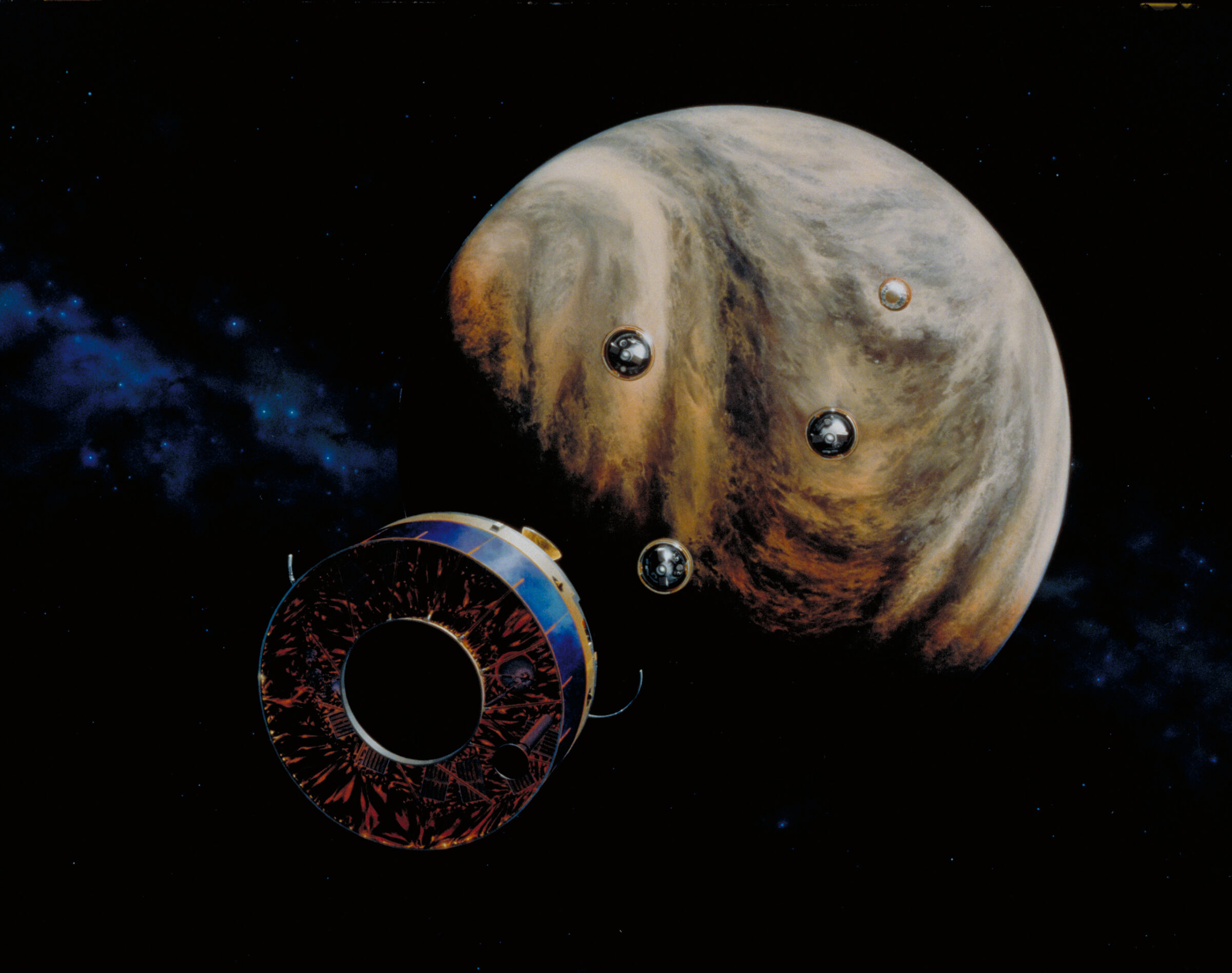
The former Soviet Union is the undisputed leader of Venus surface missions, having received data from roughly a dozen landers between 1970 and 1985. Four of the country’s Venera spacecraft captured pictures that you’ll see later in this issue.
NASA is the only other entity to successfully transmit data from Venus’ surface. In 1978, the space agency launched 2 missions as part of its Pioneer Venus program. The first was an orbiter that studied the planet for 14 years. The second, known as the Pioneer Venus Multiprobe, took a much closer look.
As it approached Venus, Pioneer Venus Multiprobe split into 5 separate spacecraft. The spacecraft bus, depicted in the above picture at lower left, made measurements before burning up in the upper atmosphere. A large single probe, seen leading the pack in the upper right, used a parachute to float all the way to the surface. As expected, it stopped transmitting upon impact. The 3 identical silver probes in the middle had no parachutes and smacked into the surface at high speed. Incredibly, 2 survived, and 1 functioned for more than an hour.
Data from the multiprobe mission showed that the planet’s atmosphere is relatively haze-free beneath 30 kilometers (19 miles) and that there is little variance in temperature around the planet below 50 kilometers (31 miles). Later in this issue, you’ll learn how archival data from Pioneer Venus Multiprobe are being reexamined for indications of phosphine, a chemical associated with life.
In Context
...Looking Ahead
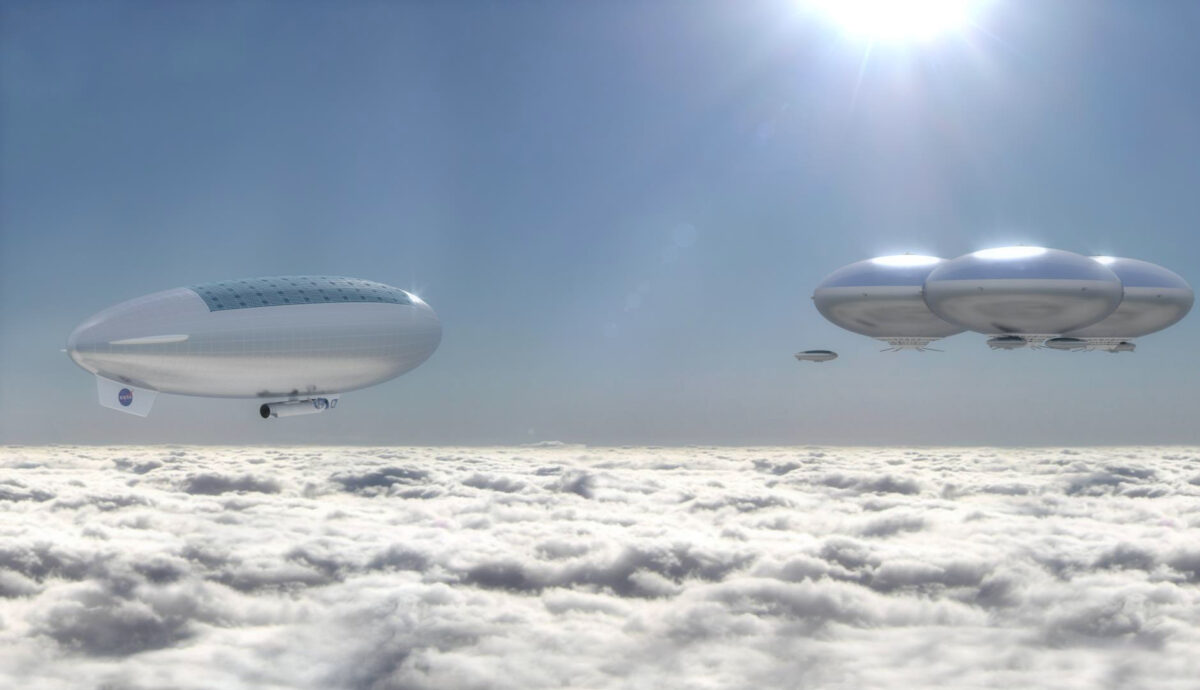
For most space enthusiasts, Venus doesn’t jump to the top of the list when it comes to potential vacation spots. While that’s certainly true for the planet’s hellish surface, some areas in the upper atmosphere are surprisingly Earthlike. In 1985, the Soviet Union’s Vega 1 and 2 probes used balloons to float through Venus’ clouds, collecting data. Scientists, engineers, and science-fiction writers have envisioned that giant balloons or airships could one day ferry human explorers around the planet.
NASA’s Langley Research Center recently studied the feasibility of Venus airships with HAVOC, the High Altitude Venus Operational Concept. Though HAVOC sparks the imagination, it isn’t likely to happen anytime soon. Among the challenges are delivering the airships to the right place and then inflating them, protecting them from the atmosphere’s persistent sulfuric acid, and perfecting a reliable way to get humans back to Earth. One possibility is the rocket you can see hanging underneath the left airship.
Despite the challenges, a mission like HAVOC is not impossible. NASA’s study con- cludes that “with advances in technology and further refinement of the concept, missions to the Venusian atmosphere can expand humanity’s future in space.”
Get Involved
The 2021 Day of Action

On 31 March 2021, The Planetary Society will hold our Day of Action, an annual event that brings together Planetary Society members to meet with their representatives in Congress and advocate for support of space science and exploration. Due to the coronavirus pandemic, this will be a virtual event. Registration is now closed for meetings, but you can still support the Day of Action by calling your representatives in government, sharing key talking points with your communities, and brushing up on your knowledge of space policy. Go to planetary.org/dayofaction to learn more.
Keep Advancing Our Advocacy Work
Right now, we’re fundraising to support our space policy and advocacy program, helping to advance activities like the Day of Action. If our work advocating for space science and exploration funding is important to you, we urge you to go to planetary.org/takeaction to make a gift toward this program today. Your support will allow us to have a presence in Washington, D.C., making sure that space is always a priority for our members’ representatives in government.
Don’t Miss a Mars Moment
Three new missions have arrived at Mars, and like parents of a new baby, we’re excited for every first: the first images sent from the planet’s surface, the first discoveries made, and the very exciting first flight of the Mars helicopter Ingenuity. To make sure that you’re tuned in to every mission milestone, keep an eye on our Mars page at planetary.org/mars and make sure you’re subscribed to our weekly email newsletter, The Downlink, at planetary.org/connect. Together, we won’t miss a single moment of the excitement.
Celebrate Space on Yuri’s Night
Every year on 12 April, the whole world celebrates an epic accomplishment: the first human to fly in space. This year is a very special anniversary. Yuri Gagarin, a Soviet cosmonaut, took this monumental flight 60 years ago on 12 April 1961. Go to yurisnight.net to find great online and at-home activities and invite your loved ones to join the celebration of 60 years in space.
Space at Home: Organize a Launch Party!
Watch parties are a fun and informal way to bring together your family or other loved ones to experience the excitement of space exploration. Enjoying a milestone moment in spaceflight can be entertaining and educational and creates a great opportunity to share The Planetary Society’s mission with more people.
Whether you’re watching with the people in your household, gathering virtually, or planning something for after the pandemic, here are some tips for organizing events to celebrate space exploration milestones
- Find out what’s launching. Stay up to speed with planetary science and exploration mission milestones by subscribing to our weekly email newsletter The Downlink at planetary.org/connect. If you’re interested in seeing more than planetary missions, there are always lots of satellite launches taking place. You can find more by searching the web.
- Find a stream. The Planetary Society live streams launches of missions that relate to our core enterprises at planetary.org/live and announces these streams in The Downlink. You’ll also usually find a link to a stream on the launching space agency or company’s website, press room, or YouTube channel. The website or press room will usually tell you in advance where the stream link will be found.
- Plan a “run of show.” Write down a schedule for the event and what you plan to do to fill the time before and after. Remember that launches are often delayed. Be prepared with a backup activity, like a discussion topic, a game, or something else space-related to watch.
- Have fun! Turn up the volume so you can hear the roar of the rocket engines, cheers (perhaps virtually) with your friends when the launch is deemed nominal, and talk with one another about the excitement of space exploration! If you really love watching a launch from home, start thinking about planning a trip to go see one in person someday. Trust us, it’s addictive!
What's Up?
In the Sky
By Bruce Betts, Planetary Society Chief Scientist
Mars is in the evening west looking like a bright reddish star. Very bright Jupiter and yellowish Saturn are in the predawn east. Mercury is very low in the west in May. A total lunar eclipse on 26 May 2021 will be visible from eastern Asia, Australia, the Pacific, and the Americas. On 10 June 2021, an annular solar eclipse will be visible from limited portions of Canada, Greenland, and Russia with a partial solar eclipse visible from the northeastern U.S. and Canada, Europe, and Russia.
Random Space Fact
A solar day on Venus is about 117 Earth days long. That is how long it takes Venus to rotate so the Sun is at the same place in the sky. A solar day is what we commonly call a day: 24 hours on Earth. A sidereal day on Venus is 243 Earth days. That is the time for a single rotation relative to the distant stars, which is 23 hours and 56 minutes for Earth.
Trivia Contest
Our September equinox contest winner is Kathleen MacDougall of San Francisco, California, USA. Congratulations! The question was: In 2020, about how much farther away is the Moon from Earth (average distance) than it was when The Planetary Society was founded in 1980? The answer: About 1.5 meters.
Try to win a copy of Space Exploration for Kids by Bruce Betts and a Planetary Radio T-shirt by answering this question:
For more than 5 years, the Japanese Akatsuki spacecraft has been orbiting and studying Venus. What does “Akatsuki” mean in English?
Email your answer to [email protected] or mail your answer to The Planetary Report, 60 S. Los Robles Ave., Pasadena, CA 91101. Make sure you include the answer and your name, mailing address, and email address (if you have one). By entering this contest, you are authorizing The Planetary Report to publish your name and hometown. Submissions must be received by 1 June 2021. The winner will be chosen in a random drawing from among all the correct entries received.
For a weekly dose of “What’s Up?” complete with humor, a weekly trivia
contest, and a range of significant space and science-fiction guests,
listen to Planetary Radio at planetary.org/radio.
Facts Worth Sharing
A Quick Guide to Venus
Venus Compared With Earth
Volume:
86% of Earth
Average Distance From the Sun:
Venus: 0.72 AU
Earth: 1 AU
Diameter:
Venus: 12,104 km
Earth: 12,742 km
Average Surface Temperature:
Venus: 460 degrees C/860 degrees F
Earth: 14 degrees C/57 degrees F
Average Distance From Sun:
Venus: 108 M km/67 M mi
Earth: 150 M km/93 M mi
Orbit Duration:
Venus: 224.7 days
Earth: 365.2 days
Moons:
Venus: 0
Earth: 1
Day:
Venus: 117 Earth Days
Earth: 1
Did You Know?
- Venus is the second-brightest natural object in the night sky after the Moon.
- Venus is named after the Roman goddess of love and beauty.
- Venus was the first planet to be visited by a spacecraft; Mariner 2 flew by on 14 December 1962.
- Venus has more volcanoes than any planet in the solar system.
Facts Worth Sharing
- Venus, the second planet from our Sun, may have had oceans and may have been habitable to life before being transformed into an inhospitable wasteland.
- Of all the solar system’s planets, Venus is the most Earthlike. The two bodies are almost the same size, and Venus’ composition is very similar to Earth’s. Both have thick atmospheres with clouds, though the composition of each atmosphere is different.
- By studying Venus, scientists learn how Earthlike planets change over time and what conditions might be like on Earth-sized planets orbiting other stars.
- Scientists have predicted that life could currently exist in Venus’ upper atmosphere, where some regions have Earthlike temperatures and pressures.
- The air pressure on the surface of Venus is almost 90 times higher than the pressure at sea level on Earth.
- Winds can sweep through Venus’ atmosphere at up to 725 kilometers per hour (450 mph).
- If viewed from above, Venus rotates on its axis in a direction that’s the opposite of most planets’. That means on Venus, the sun would appear to rise in the west and set in the east. Weird!
Notable Missions
Mariner 2 (1962):
NASA’s Mariner 2 was a flight spare for Mariner 1, which failed on the way to Venus. The spacecraft performed the first planetary flyby, detecting hot temperatures and high pressures, a carbon dioxide atmosphere, and no magnetic field.
Venera 7 (1970):
The Soviet Union’s Venera 7 returned the first data from Venus’ surface. It survived for 23 minutes, recording temperatures of 475 degrees Celsius (887 degrees Fahrenheit). Other measurements revealed light winds and pressures 92 times that of Earth.
Magellan (1989-1994):
NASA’s Magellan used radar to pierce Venus’ clouds and make the best global surface map to date. The spacecraft captured the planet’s features and topography in resolutions of roughly 100 meters per pixel.
Venus Express (2005-2015):
The European Space Agency’s Venus Express found granitelike rocks that form in liquid water on Earth. The mission also found Venus sheds hydrogen and oxygen, which could be remnants of long-gone oceans.
Astronomical Art
David A. Hardy, Volcanoes of Venus
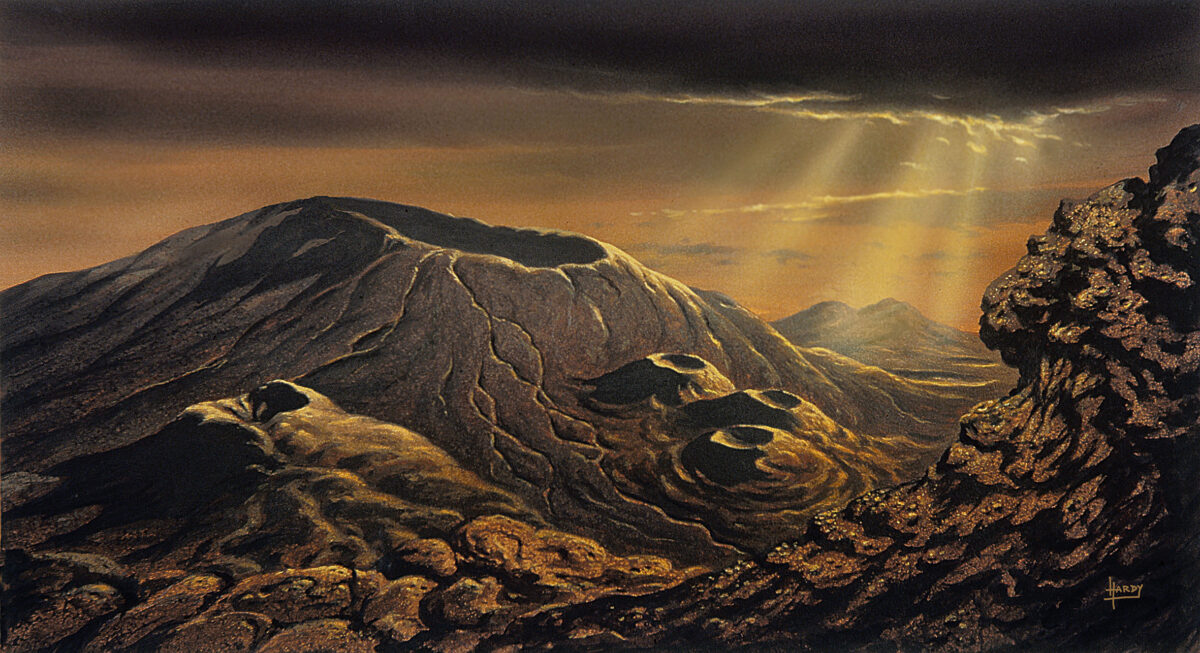
Until the advent of robotic spacecraft, when humans looked at Venus, we could only see a bland white disc with thick clouds obscuring the surface. Many types of surfaces were proposed, from prehistoric forests to planet-wide oceans or a wind-blown dust bowl. We now know Venus to have an arid, cracked landscape dotted with great volcanic formations. This artwork by longtime Planetary Society member David A. Hardy shows a view of the Venusian surface as it may look beneath the clouds.
Do you want to see your artwork here? We love to feature our members throughout this magazine. Send your original, space-related artwork to [email protected].
The Planetary Report • March Equinox 2021
Help advance space science and exploration! Become a member of The Planetary Society and you'll receive the full PDF and print versions of The Planetary Report.


 Explore Worlds
Explore Worlds Find Life
Find Life Defend Earth
Defend Earth





